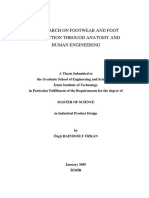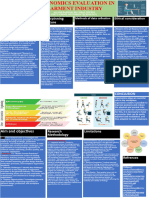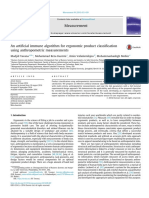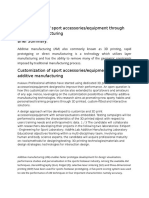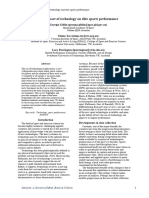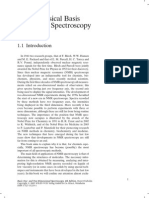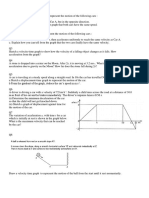Professional Documents
Culture Documents
Review of Biomechanics in Footwear Design and Development: An Exploration of Key Concepts and Innovations
Review of Biomechanics in Footwear Design and Development: An Exploration of Key Concepts and Innovations
Original Title
Copyright
Available Formats
Share this document
Did you find this document useful?
Is this content inappropriate?
Report this DocumentCopyright:
Available Formats
Review of Biomechanics in Footwear Design and Development: An Exploration of Key Concepts and Innovations
Review of Biomechanics in Footwear Design and Development: An Exploration of Key Concepts and Innovations
Copyright:
Available Formats
Volume 9, Issue 4, April – 2024 International Journal of Innovative Science and Research Technology
ISSN No:-2456-2165 https://doi.org/10.38124/ijisrt/IJISRT24APR807
Review of Biomechanics in Footwear Design and
Development: An Exploration of Key
Concepts and Innovations
1
Loganathan. T; 2Anila Sasi; 3Ruchi Singh
1
Faculty, 2Jr. Faculty, 3Faculty
1,2
Department of FDP in Footwear Design and Development Institute, Ministry of Commerce and Industry, Govt of India
3
Department of Leather Goods and Accessories Design in Footwear Design and Development Institute,
Ministry of Commerce and Industry, Govt of India
Abstract:- Biomechanics plays a pivotal role in shaping during various activities.[6] By analysing the forces,
the design and development of footwear, exerting stresses, and motions involved in locomotion,
influence over critical factors such as comfort, biomechanisms and footwear designers collaborate to create
performance, and injury prevention. This paper offers a footwear that maximizes performance, comfort, and injury
comprehensive examination of how biomechanical prevention.[7]
principles intersect with footwear design, emphasizing
the intricate relationship between human anatomy, Biomechanical Analysis in Footwear Design
physiology, and mechanical engineering. Through a Biomechanical analysis forms the foundation of
multifaceted approach integrating biomechanical footwear design, providing insights into the mechanical
analysis, materials science, and ergonomic design, the stresses experienced by the foot during different movements.
research explores avenues for optimizing footwear to [8-10] Through techniques such as motion capture, force
elevate user experience and performance across a plate analysis, and gait analysis, researchers can quantify
spectrum of activities and environments. By scrutinizing parameters such as joint angles, ground reaction forces, and
key biomechanical elements such as impact forces, joint pressure distribution. This data informs the design of
kinetics, and gait mechanics, this study endeavours to footwear that optimally supports the foot's natural
uncover the underlying mechanisms governing footwear biomechanics, reducing the risk of injuries and enhancing
function and efficacy. The synthesis of insights gleaned performance. [11-15]
from biomechanical research informs the evolution of
footwear technology and drives innovation in the Materials Science and Ergonomic Design
industry. These findings serve as a cornerstone for the Materials science plays a crucial role in footwear
development of footwear solutions tailored to meet the design, as the selection of materials directly impacts factors
diverse needs of populations worldwide. This research such as cushioning, support, and durability. Advances in
not only sheds light on the intricate interplay between material technologies have led to the development of
biomechanics and footwear design but also contributes specialized foams, gels, and polymers that offer superior
to the advancement of the field. By elucidating the shock absorption and energy return. Ergonomic design
complex biomechanical dynamics at play, this study principles further enhance user comfort by ensuring proper
provides a roadmap for enhancing footwear fit, weight distribution, and ventilation, thereby reducing
performance, comfort, and injury prevention strategies. fatigue and discomfort during prolonged wear. [16-18]
Ultimately, the integration of biomechanical principles
into footwear design represents a transformative Biomechanics and Performance Enhancement
approach to meeting the evolving demands of users and Understanding biomechanical principles allows
fostering innovation in the footwear industry. designers to tailor footwear to the specific needs of athletes
and individuals engaged in various activities.[19] By
Keywords:- Biomechanics, Footwear Design, Performance, optimizing features such as traction patterns, midsole
Comfort, Injury Prevention. stiffness, and heel-to-toe drop, footwear can enhance
performance by improving stability, agility, and energy
I. INTRODUCTION efficiency. Biomechanical insights also inform the design of
specialized footwear for specific sports disciplines, such as
The design and development of footwear have evolved running, basketball, and soccer, where unique movement
significantly over the years, driven by advancements in patterns and biomechanical demands exist.[20]
biomechanics, materials science, and manufacturing
technologies.[5] Biomechanics, the study of the mechanical
aspects of living organisms, plays a crucial role in
understanding how the human body interacts with footwear
IJISRT24APR807 www.ijisrt.com 653
Volume 9, Issue 4, April – 2024 International Journal of Innovative Science and Research Technology
ISSN No:-2456-2165 https://doi.org/10.38124/ijisrt/IJISRT24APR807
Injury Prevention and Rehabilitation Mechanical Testing: Mechanical properties such as
Biomechanics plays a crucial role in injury prevention tensile strength, compressive modulus, and hardness
and rehabilitation by identifying risk factors associated with were evaluated using a universal testing machine and
footwear design and usage. Improper footwear can durometer. Thickness measurements were also taken to
contribute to common injuries such as plantar fasciitis, assess material uniformity.
Achilles tendonitis, and stress fractures. [22-25] Through Data Analysis: Mechanical test data were analyzed to
biomechanical analysis, researchers can identify design characterize the performance and durability of different
modifications that reduce excessive loading on vulnerable shoe materials. Results were compared to industry
tissues and promote more natural foot mechanics, aiding in standards and manufacturer specifications to assess
injury prevention and recovery.[21] compliance.
Ergonomic Design Principles:
II. MATERIALS AND METHODS
Materials:
The study employed a rigorous methodology 3D foot scanner
encompassing biomechanical analysis, material testing, and CAD software (e.g., SolidWorks)
ergonomic design principles to investigate the role of Pressure mapping system (e.g., Tekscan)
biomechanics in footwear design. The following sections
detail the materials, equipment, and procedures utilized in Methods:
each aspect of the study: Foot Scanning: Participants' feet were scanned using a
3D foot scanner to capture detailed anatomical
Biomechanical Analysis: measurements.
Shoe Design: Shoe lasts were created based on the foot
A. Materials:
scans using CAD software, allowing for the
High-speed cameras (e.g., Motion Analysis Corporation)
customization of shoe shape and fit.
Force plates (e.g., AMTI)
Reflective markers Pressure Mapping: Participants wore prototype shoes
equipped with pressure sensors to assess pressure
Motion analysis software (e.g., Visual3D)
distribution during walking and running.
B. Methods: Iterative Design Process: Feedback from participants and
Participants: A diverse group of individuals representing pressure mapping data were used to refine shoe designs
different age groups, genders, and athletic backgrounds iteratively, optimizing fit, comfort, and performance.
were recruited for the study.
Experimental Setup: Participants were outfitted with IV. RESULTS
reflective markers placed on anatomical landmarks to
track joint kinematics and segmental motion. Force The results of the study are presented below, organized
plates were integrated into the floor to measure ground according to the different aspects of the research
reaction forces during locomotion. methodology.
Data Collection: Participants performed various
activities, including walking, running, jumping, and Biomechanical Analysis:
cutting manoeuvres, while motion and force data were Joint Kinematics: Analysis of joint angles during various
simultaneously recorded. activities revealed significant differences between
Data Analysis: Biomechanical parameters such as joint walking, running, and jumping. Walking exhibited a
angles, ground reaction forces, and muscle activation more symmetrical gait pattern compared to running, with
patterns were analysed using motion analysis software. lower joint excursion angles observed during walking.
Statistical analyses were conducted to identify Ground Reaction Forces: Peak vertical ground reaction
significant differences between conditions and activities. forces were highest during running and jumping
activities, indicating greater impact forces experienced
III. MATERIAL TESTING by the lower extremities during these activities.
Muscle Activation Patterns: EMG analysis showed
Materials: variations in muscle activation patterns between different
Various shoe materials (e.g., midsole foams, outsole activities, with higher activation levels observed in lower
rubbers, upper materials) limb muscles during dynamic movements such as
Universal testing machine (e.g., Instron) running and cutting manoeuvres.
Durometer (e.g., Shore A hardness tester) Material Testing: Mechanical Properties: Midsole foams
Thickness gauge demonstrated superior cushioning properties compared
to outsole rubbers, with higher compressive modulus and
Methods: energy return values. Upper materials exhibited adequate
Sample Preparation: Specimens of different shoe tensile strength and tear resistance, ensuring durability
materials were prepared according to standardized and structural integrity.
protocols, ensuring consistency in size and shape.
IJISRT24APR807 www.ijisrt.com 654
Volume 9, Issue 4, April – 2024 International Journal of Innovative Science and Research Technology
ISSN No:-2456-2165 https://doi.org/10.38124/ijisrt/IJISRT24APR807
Durometer Measurements: Shore A hardness testing enhancing physical well-being and performance. As we
revealed differences in hardness levels among different navigate the challenges and opportunities on this path, the
shoe materials, with midsole foams exhibiting lower pursuit of biomechanically optimized footwear promises to
hardness values compared to outsole rubbers. redefine the boundaries of innovation and shape the future
Ergonomic Design Principles: of footwear design for generations to come.
Foot Scanning: 3D foot scans captured detailed
anatomical measurements, facilitating the customization VI. CONCLUSION
of shoe lasts and optimizing fit.
Pressure Mapping: Pressure mapping data showed even In conclusion, the realm of biomechanics stands as a
pressure distribution across the foot during walking and cornerstone in the intricate process of crafting footwear,
running, indicating proper shoe fit and alignment. wielding significant influence over essential factors like
Iterative Design Process: Feedback from participants and comfort, performance, and injury prevention. Employing a
pressure mapping data informed iterative design multidisciplinary methodology merging biomechanical
modifications, resulting in improved shoe comfort and analysis, materials science, and ergonomic design,
performance. researchers and designers embark on a quest to fabricate
footwear that harmonizes with the natural biomechanics of
V. DISCUSSION the foot, enriching user experience across a spectrum of
activities and terrains. The relentless pursuit of integrating
The study's findings underscore the critical role of biomechanical principles into footwear design not only
biomechanics in shaping footwear design. Through a amplifies the comfort and performance of shoes but also
meticulous analysis of joint kinematics, ground reaction champions the cause of injury prevention. By understanding
forces, and muscle activation patterns, researchers gained how forces interact with the human body during movement,
profound insights into the intricate mechanical demands designers can engineer footwear that mitigates stress on
imposed on the lower extremities across diverse activities. vulnerable areas, thus reducing the likelihood of injuries.
This comprehensive understanding facilitated informed This amalgamation of science and design philosophy not
decisions regarding material selection, emphasizing the only enhances the wearer's physical well-being but also
significance of choosing shoe materials with optimal fosters a deeper sense of confidence and assurance in their
cushioning and durability attributes. Additionally, the chosen footwear. Moreover, the fusion of biomechanics with
integration of ergonomic design principles proved footwear design continually pushes the boundaries of
instrumental in tailoring shoe lasts and refining fit and innovation, heralding a future where shoes are not just
comfort, thereby enhancing the overall user experience. The utilitarian objects but holistic companions tailored to exceed
incorporation of biomechanical considerations into footwear the diverse needs and expectations of users globally. As
design not only elevates comfort and performance but also technology advances and our understanding of human
holds vast potential for future innovation and advancement. biomechanics deepens, the potential for groundbreaking
Yet, this journey is not without its challenges. Individual advancements in footwear design becomes increasingly
variability in biomechanics poses a significant obstacle, palpable. In essence, biomechanics serves as the guiding
necessitating the development of adaptable solutions that light illuminating the path toward footwear evolution, where
cater to diverse physiological profiles. Ethical concerns each stride is a testament to the symbiotic relationship
regarding human subject research and the equitable between science and human experience. As we venture
distribution of footwear innovations also warrant careful further into this realm of possibility, the journey towards
consideration. Moreover, cost constraints may impede the crafting footwear that seamlessly integrates with the human
widespread adoption of biomechanically optimized body's natural mechanics is not merely a pursuit of
footwear, highlighting the importance of striking a balance innovation but a testament to our commitment to enhancing
between innovation and accessibility. Looking ahead, future the quality of life for individuals worldwide. Through the
research endeavors are poised to explore novel avenues in lens of biomechanics, the future of footwear appears
personalized footwear solutions, leveraging individual boundless, promising a paradigm shift where every step
biomechanical profiles to tailor shoe designs to specific user taken is a step towards greater comfort, performance, and
needs. The integration of emerging technologies such as well-being.
wearable sensors and 3D printing holds particular promise in
this regard, offering unprecedented opportunities for REFERENCES
customization and optimization. By harnessing the power of
data-driven insights and cutting-edge methodologies, [1]. T. Loganathan; T. Loganathan. "Optimizing Revolution
researchers can usher in a new era of footwear design Development of Low Cost Sustainable Glide Shoe in
characterized by unparalleled comfort, performance, and Biodegradability Study in Compost Environment."
user satisfaction. In conclusion, the integration of Volume. 8 Issue. 1, January - 2023 , International
biomechanics into footwear design represents a Journal of Innovative Science and Research
transformative endeavor with far-reaching implications for Technology (IJISRT), www.ijisrt.com. ISSN - 2456-
both industry and academia. By embracing the complexities 2165, PP:- 188-192.
of human movement and anatomy, designers and researchers https://doi.org/10.5281/zenodo.7554150
can unlock the full potential of footwear as a tool for
IJISRT24APR807 www.ijisrt.com 655
Volume 9, Issue 4, April – 2024 International Journal of Innovative Science and Research Technology
ISSN No:-2456-2165 https://doi.org/10.38124/ijisrt/IJISRT24APR807
[2]. S. Jaiganesh; Loganathan.T; Vishva Kumar; K. [17]. Thatcher, Andrew, Gabriel Garcia-Acosta, and K.
Elayaraja. "Investigating Grip Study of Different Types Lange Morales. "Design principles for green
of Footwear Soling Materials in SATRA Std.” Volume. ergonomics." Contemporary ergonomics and human
Volume. 7 Issue. 4, April - 2022 , International Journal factors 1 (2013): 319-326.
of Innovative Science and Research Technology [18]. Hajiyev, Imash A. "Ergonomics as the scientific bases
(IJISRT), www.ijisrt.com. ISSN - 2456-2165, PP :- of design." Design Journal. United Kingdom-England,
1527-1529. https://doi.org/10.5281/zenodo.6827368 BLOOMSBURY PUBLISHING PLC 1460-6925 1756-
[3]. Mukherjee, M., Loganathan, T., Mandal, S., & 3062, European Academy of Design-Arts and
Saraswathy, G. (2021). Biodegradability Study of Humanities Citation Index 2014 Thmson Reuters,
Footwear Soling Materials in Simulated Compost Impakt-faktor: 1, 98 18.4 (2015): 102.
Environment. Journal of the American Leather [19]. Karwowski, Waldemar. "Ergonomics and human
Chemists Association, 116(2). factors: the paradigms for science, engineering, design,
https://doi.org/10.34314/jalca.v116i2.4236 technology and management of human-compatible
[4]. Loganathan. T, K. Elayaraja, M. Vishva kumar (2024), systems." Ergonomics 48.5 (2005): 436-463.
Eco-Friendly Leather: Durable and Crack-Resistant [20]. Kermavnar, Tjaša, Alice Shannon, and Leonard W.
Shoe Uppers. International Journal of Innovative O'Sullivan. "The application of additive
Science and Research Technology (IJISRT) manufacturing/3D printing in ergonomic aspects of
IJISRT24MAR035, 861-864. DOI: product design: A systematic review." Applied
10.38124/ijisrt/IJISRT24MAR035. Ergonomics 97 (2021): 103528.
https://www.ijisrt.com/ecofriendly-leather-durable-and- [21]. Widodo, Lamto, F. J. Daywin, and M. Nadya.
crackresistant-shoe-uppers "Ergonomic risk and work load analysis on material
[5]. Aversa, Raffaella, et al. "Biomimetic and evolutionary handling of PT. XYZ." IOP Conference Series:
design driven innovation in sustainable products Materials Science and Engineering. Vol. 528. No. 1.
development." American Journal of Engineering and IOP Publishing, 2019.
Applied Sciences 9.4 (2016). [22]. Widodo, Lamto, F. J. Daywin, and M. Nadya.
[6]. Cheung, Jason Tak-Man, et al. "Current methods in "Ergonomic risk and work load analysis on material
computer-aided engineering for footwear handling of PT. XYZ." IOP Conference Series:
design." Footwear science 1.1 (2009): 31-46. Materials Science and Engineering. Vol. 528. No. 1.
[7]. Willwacher, Steffen, and Gillian Weir. "The future of IOP Publishing, 2019.
footwear biomechanics research." Footwear [23]. Setiawan, H., and M. Rinamurti. "Recommendations of
Science 15.2 (2023): 145-154. ergonomic checkpoints and total ergonomics
[8]. Hamill, Joseph, and Barry T. Bates. "Biomechanics and intervention in the pempek kemplang palembang
footwear research 1970–2000." Footwear Science 15.2 industry." IOP Conference Series: Materials Science
(2023): 123-131. and Engineering. Vol. 885. No. 1. IOP Publishing,
[9]. Nigg, Benno Maurus, Brian R. MacIntosh, and 2020.
Joachim Mester. Biomechanics and biology of [24]. Setiawan, H., and M. Rinamurti. "Recommendations of
movement. Human Kinetics, 2000. ergonomic checkpoints and total ergonomics
[10]. Murley, George S., et al. "Effect of foot posture, foot intervention in the pempek kemplang palembang
orthoses and footwear on lower limb muscle activity industry." IOP Conference Series: Materials Science
during walking and running: a systematic review." Gait and Engineering. Vol. 885. No. 1. IOP Publishing,
& posture 29.2 (2009): 172-187. 2020.
[11]. Ferber, Reed, and Shari Macdonald. "Running [25]. Shamaileh, Anas Atef. "Critical analysis of ergonomic
mechanics and gait analysis." (2014). and materials in interior design for residential
[12]. Novacheck, Tom F. "The biomechanics of projects." Materials Today: Proceedings 65 (2022):
running." Gait & posture 7.1 (1998): 77-95. 2760-2764.
[13]. Hafner, Brian J., et al. "Energy storage and return [26]. Zatsiorsky, Vladimir, ed. Biomechanics in sport:
prostheses: does patient perception correlate with performance enhancement and injury prevention. John
biomechanical analysis?." Clinical Biomechanics 17.5 Wiley & Sons, 2008.
(2002): 325-344. [27]. Nazari, Farhad, and Ali Fatahi. "Football Biomechanics
[14]. McGinnis, Peter Merton. Biomechanics of sport and and Performance Enhancement: A Systematic
exercise. Human Kinetics, 2013. Review." Journal of Sport Biomechanics 9.3 (2023):
[15]. Wilson, Margaret, and Young-Hoo Kwon. "The role of 252-270.
biomechanics in understanding dance movement: a [28]. Li, Li. "How can sport biomechanics contribute to the
review." Journal of Dance Medicine & Science 12.3 advance of world record and best athletic
(2008): 109-116. performance?." Measurement in Physical Education
[16]. Chowdhury, Anirban, et al. "Nanomaterials in the field and Exercise Science 16.3 (2012): 194-202.
of design ergonomics: present [29]. McDevitt, Sam, et al. "Wearables for biomechanical
status." Ergonomics 55.12 (2012): 1453-1462. performance optimization and risk assessment in
industrial and sports applications." Bioengineering 9.1
(2022): 33.
IJISRT24APR807 www.ijisrt.com 656
Volume 9, Issue 4, April – 2024 International Journal of Innovative Science and Research Technology
ISSN No:-2456-2165 https://doi.org/10.38124/ijisrt/IJISRT24APR807
[30]. Liu, Joseph, et al. "Development of an integrated
biomechanics informatics system with knowledge
discovery and decision support tools for research of
injury prevention and performance
enhancement." Computers in biology and medicine 141
(2022): 105062.
[31]. Derby, Hunter, et al. "Occupational footwear design
influences biomechanics and physiology of human
postural control and fall risk." Applied Sciences 13.1
(2022): 116.
[32]. Taunton, J. E., D. C. McKenzie, and D. B. Clement.
"The role of biomechanics in the epidemiology of
injuries." Sports medicine 6 (1988): 107-120.
[33]. Ceyssens, Linde, et al. "Biomechanical risk factors
associated with running-related injuries: a systematic
review." Sports medicine 49 (2019): 1095-1115.
[34]. Hreljac, Alan. "Etiology, prevention, and early
intervention of overuse injuries in runners: a
biomechanical perspective." Physical Medicine and
Rehabilitation Clinics 16.3 (2005): 651-667.
[35]. Sinclair, Jonathan, et al. "Gender differences in the
kinetics and kinematics of distance running:
implications for footwear design." International
Journal of Sports Science and Engineering 6.2 (2012):
118-128.
[36]. Barnes, R. A., and P. D. Smith. "The role of footwear
in minimizing lower limb injury." Journal of Sports
Sciences 12.4 (1994): 341-353.
[37]. Finch, Caroline F., Shahid Ullah, and Andrew S.
McIntosh. "Combining epidemiology and
biomechanics in sports injury prevention research: a
new approach for selecting suitable controls." Sports
medicine 41 (2011): 59-72.
IJISRT24APR807 www.ijisrt.com 657
You might also like
- Principles of Flight Mike Burton V3Document122 pagesPrinciples of Flight Mike Burton V3ChetanPrajapatiNo ratings yet
- Virtual Training Centre For Shoe DesignDocument56 pagesVirtual Training Centre For Shoe DesignStevenNo ratings yet
- The Modified Roschin Godin Searl Generators: (M-RG-Searl-G) Mahmoud E. YousifDocument8 pagesThe Modified Roschin Godin Searl Generators: (M-RG-Searl-G) Mahmoud E. YousifJohnsro LiktroNo ratings yet
- SMPS ForwardConverterTypePCDocument17 pagesSMPS ForwardConverterTypePCNAYEEMNo ratings yet
- IAL AS Physics SN 6Document67 pagesIAL AS Physics SN 6Mohamed Al Sharkawy86% (7)
- Design of A Novel Carbon-Fiber Ankle-Foot Prosthetic Using Finite Element ModelingDocument16 pagesDesign of A Novel Carbon-Fiber Ankle-Foot Prosthetic Using Finite Element ModelingThomson JohnyNo ratings yet
- Aircraft Presentation 26july18Document41 pagesAircraft Presentation 26july18M.Mohamed SarfrazNo ratings yet
- Settling and SedimentationDocument28 pagesSettling and SedimentationPratiksha GoreNo ratings yet
- Modelling and Analysis of A Prosthetic Runner BladeDocument11 pagesModelling and Analysis of A Prosthetic Runner BladeIJRASETPublicationsNo ratings yet
- Research On Footwear and FootDocument174 pagesResearch On Footwear and FootL.E. VelezNo ratings yet
- 3AP-3FI - Mach Noi BoDocument168 pages3AP-3FI - Mach Noi BoBảo NguyễnNo ratings yet
- A Research On Footwear and FootDocument174 pagesA Research On Footwear and FootL.E. Velez100% (2)
- Course IntroductionDocument11 pagesCourse IntroductionAdisuNo ratings yet
- Iso 2178Document6 pagesIso 2178Hung DinhNo ratings yet
- International Design ConferenceDocument16 pagesInternational Design ConferenceSina AryanNo ratings yet
- Development and Presentation of The FirsDocument15 pagesDevelopment and Presentation of The FirsRafael Ribeiro Dos SantosNo ratings yet
- A Knowledge-Based Design Process For Diabetic Shoe LastsDocument12 pagesA Knowledge-Based Design Process For Diabetic Shoe Lastsعباس السواريNo ratings yet
- Manufacturing Methodology For Personalised Symptom Specific Sports PDFDocument16 pagesManufacturing Methodology For Personalised Symptom Specific Sports PDFAaiesha MohammedNo ratings yet
- Improving Comfort of Shoe Sole Through Experiments Based On CAD-FEM ModelingDocument12 pagesImproving Comfort of Shoe Sole Through Experiments Based On CAD-FEM ModelingsandeepNo ratings yet
- Castiblanco (2017Document12 pagesCastiblanco (2017Asesor PSSNo ratings yet
- UdhvidhjDocument1 pageUdhvidhjTHAKUR MANISH JIINo ratings yet
- Therunningshoecomfortassessmenttool RUNCATDevelopmentandevaluationofanewmultiitemassessmenttoolforevaluatingthecomfortofrunningDocument10 pagesTherunningshoecomfortassessmenttool RUNCATDevelopmentandevaluationofanewmultiitemassessmenttoolforevaluatingthecomfortofrunningBruno FariaNo ratings yet
- RetrieveDocument28 pagesRetrieveFlor Gabriela Cruz GarzonNo ratings yet
- Bionic ThesisDocument12 pagesBionic ThesisRohan PorelNo ratings yet
- Ergonomics Foot Wear Anthropometry PDFDocument2 pagesErgonomics Foot Wear Anthropometry PDFMariara0% (1)
- Pallari Et Al 2010Document8 pagesPallari Et Al 2010Andres ReinosoNo ratings yet
- 1 s2.0 S2095809920302575 MainDocument9 pages1 s2.0 S2095809920302575 MainWAHYU DWI LESTARINo ratings yet
- Measurement: Madjid Tavana, Mohammad Reza Kazemi, Amin Vafadarnikjoo, Mohammadsadegh MobinDocument9 pagesMeasurement: Madjid Tavana, Mohammad Reza Kazemi, Amin Vafadarnikjoo, Mohammadsadegh MobinGhina AlmiraNo ratings yet
- Journal Fisio Laprak Mekanika 1Document18 pagesJournal Fisio Laprak Mekanika 1Ahmad SaipudinNo ratings yet
- Tricycle IJCApdfDocument9 pagesTricycle IJCApdfİsmail KoçNo ratings yet
- Evaluation On Diabetic Plantar Pressure Data-Set Employing Auto-Segmentation TechnologiesDocument14 pagesEvaluation On Diabetic Plantar Pressure Data-Set Employing Auto-Segmentation TechnologiesWelly DiasNo ratings yet
- Applied Ergonomics: Tja Sa Kermavnar, Alice Shannon, Leonard W. O'SullivanDocument19 pagesApplied Ergonomics: Tja Sa Kermavnar, Alice Shannon, Leonard W. O'SullivanAlexandrina BugaNo ratings yet
- ShoedisplayDocument8 pagesShoedisplayTashila MalshiNo ratings yet
- Designing and Ergonomic Evaluation of A Shoe-RackDocument5 pagesDesigning and Ergonomic Evaluation of A Shoe-RackSakshamNo ratings yet
- LAB MANUAL PBL Saiful 1Document4 pagesLAB MANUAL PBL Saiful 1NUR AISYAH MAISARAH BT MOHAMAD ZAINI A19EB0067No ratings yet
- Gender and Leg-Dominance Differences in Shoe PropeDocument11 pagesGender and Leg-Dominance Differences in Shoe PropeAbdelghani MILIANINo ratings yet
- 42 - ACMSEA - Rajesh (3) GGGDocument9 pages42 - ACMSEA - Rajesh (3) GGGNada GhammemNo ratings yet
- Boxers' Intention To Use Smart Boxing Gloves in Training Using Industry 4.0 Sports TechnologyDocument11 pagesBoxers' Intention To Use Smart Boxing Gloves in Training Using Industry 4.0 Sports TechnologyInternational Journal of Innovative Science and Research TechnologyNo ratings yet
- RM DraftDocument5 pagesRM DraftPooja GuptaNo ratings yet
- Magrassi 1Document8 pagesMagrassi 1danieleNo ratings yet
- From 3D Foot Scans To Footwear Designing & Production: November 2014Document10 pagesFrom 3D Foot Scans To Footwear Designing & Production: November 2014ВикаNo ratings yet
- A 3-Dimensional Finite Element Analysis of The Insole Shoe Orthotic For Foot DeformitiesDocument7 pagesA 3-Dimensional Finite Element Analysis of The Insole Shoe Orthotic For Foot DeformitiesSuzanaPetrovicNo ratings yet
- Additive Manufacturing of Biomaterials For Bone TissueDocument43 pagesAdditive Manufacturing of Biomaterials For Bone TissuedayseanedNo ratings yet
- IJCRT2104541Document11 pagesIJCRT2104541InstagramNo ratings yet
- SPOrts EquipmentDocument3 pagesSPOrts EquipmentGia NneNo ratings yet
- Preliminary Evaluation of Prototype Footwear and Insoles To Optimise Balance and Gait in Older PeopleDocument8 pagesPreliminary Evaluation of Prototype Footwear and Insoles To Optimise Balance and Gait in Older PeopleBimo AnggoroNo ratings yet
- Analysis of Shoe Manufacturing Factory by SimulatiDocument9 pagesAnalysis of Shoe Manufacturing Factory by SimulatiahmetNo ratings yet
- Ryan - minimalistfootwearBJSM 2013Document8 pagesRyan - minimalistfootwearBJSM 2013Shaun TylerNo ratings yet
- 3 Abs Pla Hdpe Foot ProstheticDocument18 pages3 Abs Pla Hdpe Foot ProstheticWAHYU DWI LESTARINo ratings yet
- National Institute of Fashion Technology BFT - Iv End Term Submission - Jan-June 2020 Subject: Industrial EngineeringDocument2 pagesNational Institute of Fashion Technology BFT - Iv End Term Submission - Jan-June 2020 Subject: Industrial Engineeringabhimanyu yadavNo ratings yet
- 1 s2.0 S2452199X20300049 MainDocument10 pages1 s2.0 S2452199X20300049 Mainluis miguel ballesteros ospinaNo ratings yet
- Ai Performance SportsDocument2 pagesAi Performance SportsDavid RuedaNo ratings yet
- 10 5923 J Clothing 20160301 01Document10 pages10 5923 J Clothing 20160301 01Abhinav AshishNo ratings yet
- Relationship Between Sprint Capacity and Acceleration of Wrists in Wheelchair Basketball Players - Design and Reliability of A New ProtocolDocument11 pagesRelationship Between Sprint Capacity and Acceleration of Wrists in Wheelchair Basketball Players - Design and Reliability of A New ProtocolMiguel HenriquezNo ratings yet
- Sustainability 14 07602Document24 pagesSustainability 14 07602ALBER DUQUENo ratings yet
- Wearable Design RequirementsDocument28 pagesWearable Design RequirementsErna TamiziNo ratings yet
- Materials 16 06132 v2Document20 pagesMaterials 16 06132 v2vNo ratings yet
- Designing Anthropometrics Requirements Capture ForDocument18 pagesDesigning Anthropometrics Requirements Capture FormeiguminsNo ratings yet
- Analysis of Shoe Manufacturing Factory by SimulatiDocument9 pagesAnalysis of Shoe Manufacturing Factory by Simulatikha.phamnguyenchucNo ratings yet
- Materials: Advances in Orthotic and Prosthetic Manufacturing: A Technology ReviewDocument15 pagesMaterials: Advances in Orthotic and Prosthetic Manufacturing: A Technology ReviewBapina Kumar RoutNo ratings yet
- Sensors 21 05972 v2Document12 pagesSensors 21 05972 v2PODOSALUD HUANCAYONo ratings yet
- Customization of Sport Accessories/equipment Through Additive Manufacturing Brief SummaryDocument4 pagesCustomization of Sport Accessories/equipment Through Additive Manufacturing Brief SummaryaustinvishalNo ratings yet
- The Low Cost Design and 3d Printing of Structural Knee Orthotics For Athletic Knee Injury PatientsDocument7 pagesThe Low Cost Design and 3d Printing of Structural Knee Orthotics For Athletic Knee Injury PatientsİTYNo ratings yet
- 436 1596 1 PBDocument7 pages436 1596 1 PBhrithik581No ratings yet
- 5.IJAEST Vol No 6 Issue No 2 Comparison On Jaipur, SACH and Madras Foot 187 192Document6 pages5.IJAEST Vol No 6 Issue No 2 Comparison On Jaipur, SACH and Madras Foot 187 192Adal ArasuNo ratings yet
- Basket Ball NotesDocument126 pagesBasket Ball NotesTrilok MaanjuNo ratings yet
- Landing Impact Analysis of Sports Shoes Using 3-D Coupled Foot-Shoe Finite Element ModelDocument9 pagesLanding Impact Analysis of Sports Shoes Using 3-D Coupled Foot-Shoe Finite Element ModelRedy AdbNo ratings yet
- IJCSS-Volume14 2015 Edition2 Ting Et AlDocument18 pagesIJCSS-Volume14 2015 Edition2 Ting Et AlDr ManiNo ratings yet
- Thickness CipherDocument3 pagesThickness CipherInternational Journal of Innovative Science and Research TechnologyNo ratings yet
- The Impact of Store Atmosphere and Customer Experience on Consumer Purchasing Decisions of KFC Wahidin GresikDocument5 pagesThe Impact of Store Atmosphere and Customer Experience on Consumer Purchasing Decisions of KFC Wahidin GresikInternational Journal of Innovative Science and Research TechnologyNo ratings yet
- Human Resource Functions: Examining Insights from ABC Research OrganizationDocument9 pagesHuman Resource Functions: Examining Insights from ABC Research OrganizationInternational Journal of Innovative Science and Research TechnologyNo ratings yet
- Utilizing Chicken Eggshells and Waste Glass Powder as Cement Fillers for Environmental StabilityDocument6 pagesUtilizing Chicken Eggshells and Waste Glass Powder as Cement Fillers for Environmental StabilityInternational Journal of Innovative Science and Research TechnologyNo ratings yet
- An Appraisal of Employable Content of the National Diploma in Architectural Technology Program in North East NigeriaDocument5 pagesAn Appraisal of Employable Content of the National Diploma in Architectural Technology Program in North East NigeriaInternational Journal of Innovative Science and Research TechnologyNo ratings yet
- The Impact of the Commercial Agriculture Credit Scheme (CACS) on the Agricultural Economy of Nigeria and its Total Output (2015-2019)Document8 pagesThe Impact of the Commercial Agriculture Credit Scheme (CACS) on the Agricultural Economy of Nigeria and its Total Output (2015-2019)International Journal of Innovative Science and Research TechnologyNo ratings yet
- The Expanding Attack Surface: Securing AI and Machine Learning Systems in Security OperationsDocument8 pagesThe Expanding Attack Surface: Securing AI and Machine Learning Systems in Security OperationsInternational Journal of Innovative Science and Research Technology100% (1)
- Study of prevalence of Head Lice (Pediculus Humanus Capitis) Among Schoolchildren in the Zawiya Region, LibyaDocument10 pagesStudy of prevalence of Head Lice (Pediculus Humanus Capitis) Among Schoolchildren in the Zawiya Region, LibyaInternational Journal of Innovative Science and Research Technology0% (1)
- The Impact of Termite Activity on the Availability of Soil Micronutrients in Tropical RegionsDocument6 pagesThe Impact of Termite Activity on the Availability of Soil Micronutrients in Tropical RegionsInternational Journal of Innovative Science and Research Technology100% (1)
- Teacher-Induced Academic Stress: Predicting Eating Behavior Problems in College StudentsDocument8 pagesTeacher-Induced Academic Stress: Predicting Eating Behavior Problems in College StudentsInternational Journal of Innovative Science and Research TechnologyNo ratings yet
- Modern Approaches to Sustainable AgricultureDocument10 pagesModern Approaches to Sustainable AgricultureInternational Journal of Innovative Science and Research Technology100% (1)
- Conceptualized Fusion Reactor based on Gas Turbine with High Temperature CO2Document7 pagesConceptualized Fusion Reactor based on Gas Turbine with High Temperature CO2International Journal of Innovative Science and Research TechnologyNo ratings yet
- Integrating Quantum Algorithms with Gravitational-Wave Metrology for Enhanced Signal DetectionDocument18 pagesIntegrating Quantum Algorithms with Gravitational-Wave Metrology for Enhanced Signal DetectionInternational Journal of Innovative Science and Research Technology100% (1)
- Transforming Challenges to Victories: An Inquiry on Transformational Leadership of School Leaders in the Public Elementary SchoolsDocument54 pagesTransforming Challenges to Victories: An Inquiry on Transformational Leadership of School Leaders in the Public Elementary SchoolsInternational Journal of Innovative Science and Research TechnologyNo ratings yet
- Strategic Deployment of Ducklink Wireless Devices For Disaster Mitigation and Management in Nueva ECIJA University of Science and Technology Sumacab CampusDocument13 pagesStrategic Deployment of Ducklink Wireless Devices For Disaster Mitigation and Management in Nueva ECIJA University of Science and Technology Sumacab CampusInternational Journal of Innovative Science and Research TechnologyNo ratings yet
- The Influence of Continuance Commitment on Job Satisfaction of Barangay Health Workers in Malaybalay City, BukidnonDocument14 pagesThe Influence of Continuance Commitment on Job Satisfaction of Barangay Health Workers in Malaybalay City, BukidnonInternational Journal of Innovative Science and Research TechnologyNo ratings yet
- Intelligent Clinical Documentation: Harnessing Generative AI For Patient-Centric Clinical Note GenerationDocument15 pagesIntelligent Clinical Documentation: Harnessing Generative AI For Patient-Centric Clinical Note GenerationInternational Journal of Innovative Science and Research TechnologyNo ratings yet
- Assessment of Integrated Poultry Manure and Synthetic Fertilizer Effects on Maize (Zea mays) Growth and Soil Properties: A Study from Bayero University, KanoDocument15 pagesAssessment of Integrated Poultry Manure and Synthetic Fertilizer Effects on Maize (Zea mays) Growth and Soil Properties: A Study from Bayero University, KanoInternational Journal of Innovative Science and Research Technology100% (1)
- Meta Land: Redefining Virtual Communities Through Centralized Governance, Inclusivity and InnovationDocument5 pagesMeta Land: Redefining Virtual Communities Through Centralized Governance, Inclusivity and InnovationInternational Journal of Innovative Science and Research TechnologyNo ratings yet
- Personal Capabilities of The Non-Teaching Personnel and Client SatisfactionDocument8 pagesPersonal Capabilities of The Non-Teaching Personnel and Client SatisfactionInternational Journal of Innovative Science and Research TechnologyNo ratings yet
- Solar Based Multilevel Inverter F o R BLDC Motor DriveDocument8 pagesSolar Based Multilevel Inverter F o R BLDC Motor DriveInternational Journal of Innovative Science and Research TechnologyNo ratings yet
- Skin Disease Detection and Remedial SystemDocument7 pagesSkin Disease Detection and Remedial SystemInternational Journal of Innovative Science and Research TechnologyNo ratings yet
- Exploring The Potential Advantages of Traditional Therapies in Autoimmune Blistering Illnesses: A Comprehensive Review and Analysis, ResearchDocument12 pagesExploring The Potential Advantages of Traditional Therapies in Autoimmune Blistering Illnesses: A Comprehensive Review and Analysis, ResearchInternational Journal of Innovative Science and Research TechnologyNo ratings yet
- EmoConnect: Nurturing Trust and Relationship Bonds in Alzheimer's ConversationsDocument3 pagesEmoConnect: Nurturing Trust and Relationship Bonds in Alzheimer's ConversationsInternational Journal of Innovative Science and Research TechnologyNo ratings yet
- Preparation and Identification of Magnetic Iron Nanoparticle Based On A Natural Hydrogel and Its Performance in Targeted Drug DeliveryDocument17 pagesPreparation and Identification of Magnetic Iron Nanoparticle Based On A Natural Hydrogel and Its Performance in Targeted Drug DeliveryInternational Journal of Innovative Science and Research TechnologyNo ratings yet
- Seasonal Variation and Distribution Patterns of Endophytic Community in Withania SomniferaDocument7 pagesSeasonal Variation and Distribution Patterns of Endophytic Community in Withania SomniferaInternational Journal of Innovative Science and Research TechnologyNo ratings yet
- Design and Development of Multi-Featured Medical StretcherDocument4 pagesDesign and Development of Multi-Featured Medical StretcherInternational Journal of Innovative Science and Research TechnologyNo ratings yet
- Development of Smart Ground Fault Location Model For Radial Distribution SystemDocument14 pagesDevelopment of Smart Ground Fault Location Model For Radial Distribution SystemInternational Journal of Innovative Science and Research TechnologyNo ratings yet
- Unlocking Sentiments: Enhancing IOCL Petrol Pump ExperiencesDocument8 pagesUnlocking Sentiments: Enhancing IOCL Petrol Pump ExperiencesInternational Journal of Innovative Science and Research TechnologyNo ratings yet
- Smart and Secure Home With ChatbotDocument9 pagesSmart and Secure Home With ChatbotInternational Journal of Innovative Science and Research TechnologyNo ratings yet
- Explain How Refraction and Reflection Phenomenon Could Be Used in Transmission SystemsDocument10 pagesExplain How Refraction and Reflection Phenomenon Could Be Used in Transmission SystemsJuan Jose PerdomoNo ratings yet
- A New Method To Calculate Power Distribution Losses in An Environment of High Unregistered LoadsDocument6 pagesA New Method To Calculate Power Distribution Losses in An Environment of High Unregistered LoadsZari YahNo ratings yet
- EDC Lab No.9 (BJT ApplicationsTransistor Switches-Security Alarm)Document4 pagesEDC Lab No.9 (BJT ApplicationsTransistor Switches-Security Alarm)sameeNo ratings yet
- Friction: Problem 509Document10 pagesFriction: Problem 509Z CharNo ratings yet
- MODULE MCO 2 (PHYSICS Wednesday 25/3/2020 9.30 - 10.30) Analysing Impulse and Impulsive Force Impulse and Impulsive ForceDocument2 pagesMODULE MCO 2 (PHYSICS Wednesday 25/3/2020 9.30 - 10.30) Analysing Impulse and Impulsive Force Impulse and Impulsive ForceZalini AbdullahNo ratings yet
- Generator Protection, Stability Checking by Using Dynamic TestingDocument5 pagesGenerator Protection, Stability Checking by Using Dynamic TestingAnonymous dqbb02DUhNo ratings yet
- Modelling of 9 Level Inverter To Reduce Total Harmonic DistortionDocument4 pagesModelling of 9 Level Inverter To Reduce Total Harmonic DistortionRavinder RangaNo ratings yet
- Lecture 5 Electric CircuitDocument20 pagesLecture 5 Electric CircuitAeron KimNo ratings yet
- Cap. 1 FriebolinDocument41 pagesCap. 1 FriebolinRuben SuarezNo ratings yet
- 500kVA Dyn5Document1 page500kVA Dyn5edwardNo ratings yet
- Exercise 2 Term 1 STPMDocument10 pagesExercise 2 Term 1 STPMLiuJiewChuan100% (1)
- Water PumpDocument8 pagesWater Pumpjvinod2025No ratings yet
- Sequence Impedances and Networks of Synchronous MachineDocument5 pagesSequence Impedances and Networks of Synchronous MachineJonathanNo ratings yet
- Parallelogram MethodDocument13 pagesParallelogram MethodMarArizalaNo ratings yet
- Slip Ring Induction Motor StarterDocument5 pagesSlip Ring Induction Motor StarterNirmal mehtaNo ratings yet
- LS MCB & RCD CatalogDocument56 pagesLS MCB & RCD Catalogkmleongmy100% (1)
- Poly TD Elt1Document75 pagesPoly TD Elt1yassir TGNo ratings yet
- Science 6 Quarter 3 Module 1Document32 pagesScience 6 Quarter 3 Module 1JAS SAJNo ratings yet
- Chapter 27 Magnetic Field and Magnetic ForcesDocument90 pagesChapter 27 Magnetic Field and Magnetic ForcesDilo TanNo ratings yet
- Harish 2009Document4 pagesHarish 2009maruthi631No ratings yet
- GRADE 8 - SCIENCE - Learning Tasks: Week 1Document2 pagesGRADE 8 - SCIENCE - Learning Tasks: Week 1Dindo Arambala OjedaNo ratings yet









